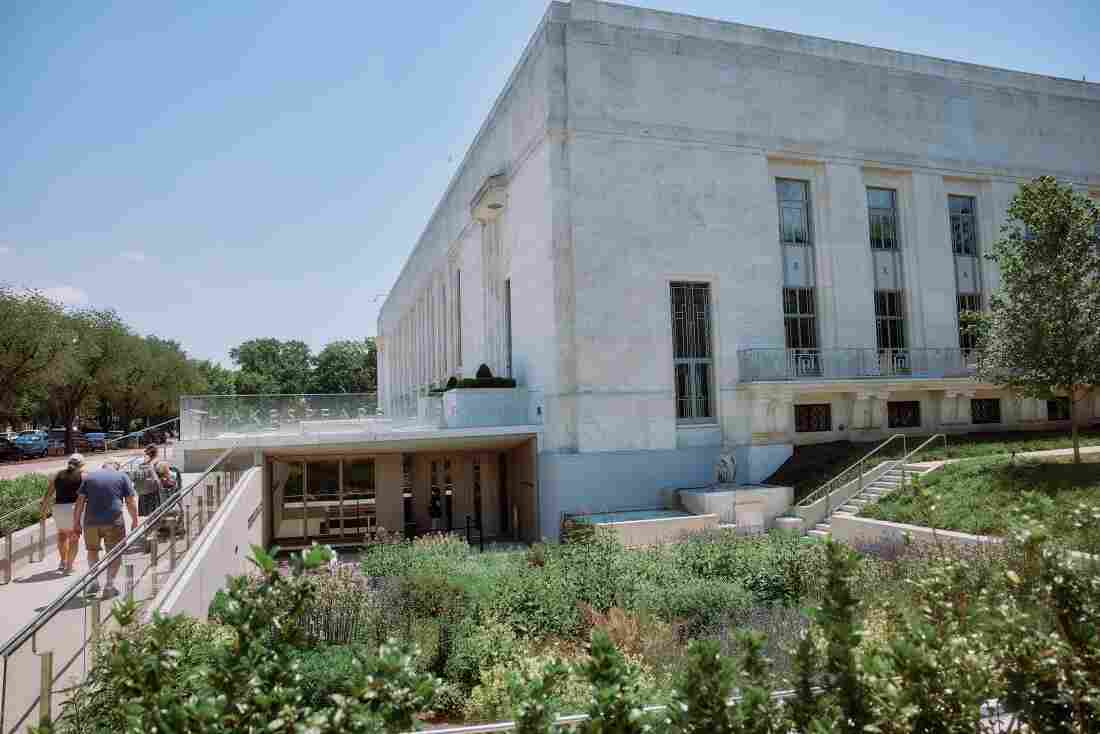
The new main exhibition hall at the Folger Shakespeare Library in Washington, D.C., on June 14, 2024.
The Folger Shakespeare Library in Washington, D.C. — home to the world’s largest Shakespeare collection — is emerging from a four-year metamorphosis that has left it almost entirely transformed — new museum spaces, new leadership announced, new programming outreach.
After years of being available only to scholars, the jewels of the library’s collection — 82 copies of Shakespeare’s “First Folio,” printed 400 years ago — will now be together on public display for the first time.
We got a behind-the-scenes sneak peek to look at how the Folger is reaching out to new audiences.
Shakespeare and the classics in Chocolate City
So much has changed at the Folger Shakespeare Library since it closed for renovations in January 2020, that it makes sense that the show reopening its performance space is called Metamorphoses. Mary Zimmerman’s adaptation of Ovid’s epic Roman poem is all about change, and Karen Ann Daniels, who directs programming for the Folger and is artistic director of its theater, sensed that it could speak to underserved audiences in D.C. if the Folger Theatre did it right.
“The play could really lean into the larger history of the populations of D.C.,” she said. “I’m totally thinking Chocolate City. That’s really where my idea came from.”
Her idea was to do the play with an all-Black cast, a notion director Psalmayene 24 wasn’t sure he was on board with until Memphis police officers fatally injured Tyre Nichols, a Black FedEx employee, last year during a traffic stop. The director said he worked through his grief at the incident by incorporating elements of the Black diaspora into Metamorphoses to celebrate Black humanity.

”The play could really lean into the larger history of the populations of DC,” said Folger Theatre Artistic Director Karen Ann Daniels, shown here in the Folger’s performance space on June 14, 2024.
“So in some ways this play is a response to America’s own proclivity for lethal anti-Blackness,” he said. “And when you do a show like this at a place like Folger, it says something about how not only Folger Theatre is changing, but how American culture is changing, how D.C. is changing, and how universal the stories that pass through this theater actually are. These stories are for everyone, and can be told in many different ways.”
The librarian has a favorite First Folio. It’s not the fanciest one.
A huge display case in the middle of the library’s new exhibition space glows softly, quietly announcing that it contains the Library’s crown jewel: 82 copies of Shakespeare’s First Folio printed in 1623 — more than a third of all the copies that are known to exist.
The First Folio marked the first time, just a few years after Shakespeare’s death, that his works were collected into a single volume, which makes it a benchmark for scholars. But no two of the copies collected by Henry and Emily Folger in their lifetime look the same. Some are skinny, others massive.

One of the Folger Shakespeare Library’s 82 copies of the First Folio, the Bard’s complete works printed in 1623, just a few years after his death.
“These were all printed in 1623,” confirmed Folger librarian and director of collections Greg Prickman, “in the printshop of William Jaggard and his son Isaac, but over the intervening 400 years a whole lot has happened to these books. Sometimes they get damaged and parts are removed. Sometimes parts are added from other copies.”
Asked if he has a favorite, he headed to the far right side of the display case, past Folios prettily bound in leather with gold tooling.
“The one that I like the most is #30 — the only copy in this collection that has the original binding that was put on when this book was first purchased, not long after it was printed.
“So, if you wanted to see, ‘What does Shakespeare’s First Folio look like when it was just another quote-unquote new book?’ that’s the copy that you’re gonna be looking at, is #30.”
A sampler of Shakespearean insults
To the right of the main display case, there’s a smaller interactive display that lets you create a Shakespearean conversation. We only spent a few moments with it, but the display makes its own selections from phrases in the Bard’s plays once you choose a category — perhaps “blessing” (“You have been nobly born”) or “burning” (“Do as thou wilt, for I have done with thee”).
We only played with it for a few minutes, but we note that the plays contain a full complement of Shakespearean insults, so in theory, it could have you spouting such Elizabethan invective as:
“Away, thou rag, thou quantity, thou remnant.” (Taming of the Shrew, Act 4, scene 3)
“I am sick when I do look on thee.” (A Midsummer Night’s Dream, Act 2, scene 1)
“I must tell you friendly in your ear, Sell when you can; you are not for all markets.” (As You Like It, Act 3, scene 5)
“More of your conversation would infect my brain.” (Coriolanus, Act 2, scene 1)
“The rankest compound of villainous smell that ever offended nostril.” (The Merry Wives of Windsor, Act 3, scene 5)
“And thou unfit for any place but hell.” (Richard III, Act 1 scene 2)
“Villain, I have done thy mother.” (Titus Andronicus, Act 4, scene 2)
“Would thou wert clean enough to spit upon!” (Timon of Athens, Act 4, scene 3)
The Mulberry Conundrum
The exhibition space has lots of rare manuscripts in a room called “Out of the Vault,” which of course made us wonder what else is in “the vault,” which is not open to the public. So we asked, and were led down a staircase to an imposing, steel, bank-vault door, behind which lie the refrigerated (“because that makes the books happy”) library stacks containing the quarter of a million other volumes in the Folger’s collection.
There are also 100,000 objects down here, ranging from paintings of the Bard, to props, costumes, models and “pieces of the tree,” said Prickman, enigmatically.

Librarian Greg Prickman is the Folger’s Director of Collections and Exhibitions.
“The mulberry tree,” he continued when pressed. “’Objects associated with Shakespearean legends’ is probably the best way to put it. I’m not the one to tell this story.”
So we looked it up.
Shakespeare allegedly planted a mulberry tree at his home in Stratford. More than a century later in the 1750s, the home’s then-owner, Rev. Francis Gastrell, got so tired of people asking to see it that he chopped it down, and local entrepreneur Thomas Sharpe bought the wood and had it crafted into Shakespearean souvenirs — everything from a carved casket that was presented to actor David Garrick (1717-1779), to snuff boxes and medallions.
So many items were created that they pretty clearly didn’t all come from one tree, but the Folger has some.
Why the Folgers placed a bet on the Humanities
The impulse to reach a more universal audience is what led Folger Library director Michael Witmore to spearhead the library’s $80.5M rethink — a wholesale “metamorphosis,” if you will, of a building and a mission that had been, frankly, functioning quite well.
“For the first part of the Folger’s existence, it was primarily a research library,” said Witmore, “serving scholars who were studying everything from animal husbandry to lyric poetry to theater. But we have the facilities and collection to do more, and this renovation allows us to take a world-class research library and surround it with a cultural institution that is a destination.”
A destination in the service of words written more than 400 years ago. Words that are also available digitally — “we digitize in order to create access, said Prickman, “and we exhibit materials in order to create access. The originals remain.”
And the presence of those originals just down the block from the Library of Congress, U.S. Capitol, and Supreme Court, was a big part of the intention of Henry and Emily Folger, said Witmore.

A view of the new underground entrance to the Folger Shakespeare Library’s exhibition areas.
“We need these words and these stories to elevate our sense of what’s possible as citizens. When you think about what happens in the Capitol, which is where words — you may not agree with them, you may think they’re funny or shallow — but it’s where words really matter. Including when the court is looking at what those words mean.
“So to put a Shakespeare library where his works are being performed, and where people are working through the poems and other things, right in this spot I think is a big bet on the importance of the humanities and the arts in a functioning democracy.”

